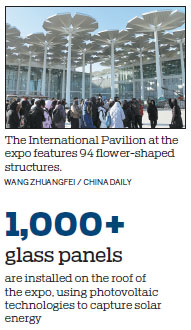Green ethos began with planning and building
As the International Horticultural Exhibition approaches, major pavilions have been unveiled, which demonstrate designers' beliefs in the green lifestyle.
In a 20-meter-high greenhouse that covers 3,000 square meters, rare plants like red sandalwood and ficus variegata are flourishing.
The Plant Pavilion, one of the major pavilions at the expo, will house up to 1,000 plant species, including more than 100 rare species, said Fu Zhongren, technical manager of the pavilion.
"The Plant Pavilion will demonstrate an amazing 'kingdom of botany' to visitors," Fu said.
The theme of this expo is "live green, live better," which is embodied in the design of the gardens and pavilions.

The Chinese Pavilion, which will display the history of Chinese gardening and horticulture, is an earth-sheltered structure. With most of its exhibition halls insulated this way, heat and humidity indoors will be better preserved, said Jing Quan, with the China Architecture Design and Research Group.
The rainwater collection system on the roof and a storage pond underground will be used for terrace field irrigation, Jing said, adding that more than 1,000 photovoltaic glass panels have been installed on the steel roof to capture solar energy.
"By taking advantage of natural conditions to save energy, the design of the Chinese Pavilion incorporates traditional Chinese architectural concepts and Chinese wisdom," Jing said.
In addition, the International Pavilion, which includes a public space made of 94 flower-shaped structures, the Performance Center, which looks like a butterfly from above, and the Life Experience Pavilion, inspired by a traditional village in northern China, all use eco-friendly materials and technologies, local media reported.
During the planning and building of the expo site, 50,000 trees were preserved and became the premise of the design. Meanwhile, more than 100,000 trees and shrubs were planted to improve the condition of wetlands, purify water and provide habitat for migratory birds.
To protect the 15-meter-tall willows lining the road to the Life Experience Pavilion, designers adjusted the foundation heights of nearby structures to better suit the tall trees.
"Despite the cost, we have managed to protect the trees. That is what matters, as ecology comes first," said Zheng Shiwei, chief designer of the pavilion.
Construction waste, such as stones and slush, has been turned into walls, roads and a 25-meter-tall hill, where visitors will be able to overlook the expo area.
Next to the expo stands Guihe River Forest Park with more than 100 kinds of plants, birds and insects. A buffer zone separates the two areas so these species will not be disturbed.
"Visitors may see abundant wildlife here, including swans, during their visit," said Cheng Guanhua, with the Beijing International Horticultural Exhibition Coordination Bureau.
Zhou Jianping, executive deputy director-general of the bureau, said ecology-prioritized principles have not only been stressed for the planning, design and construction of the expo site, but will be emphasized for its future use, such as the use of electric vehicles in the area.
Xinhua - China Daily
(China Daily 01/29/2019 page7)














